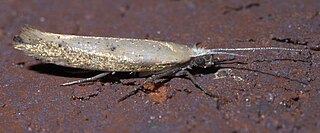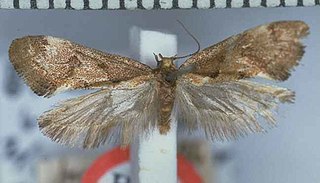Related Research Articles

Falcaria lacertinaria, the scalloped hook-tip, is a moth of the family Drepanidae. The species was first described by Carl Linnaeus in his 1758 10th edition of Systema Naturae It is found in Europe and Anatolia then east to Eastern Siberia.

Ypsolopha scabrella, the wainscot hooktip or wainscot smudge, is a moth of the family Ypsolophidae. The species was first described by Carl Linnaeus in 1761. It is found in Europe, China, Russia, Asia Minor and mideast Asia.
Xyroptila peltastes is a moth of the family Pterophoridae. It is found in Australia.

Hexadactilia trilobata is a moth of the family Pterophoridae described by Thomas Bainbrigge Fletcher in 1910. It is found in Australia in Queensland and New Guinea.
Batrachedra sterilis is a species of moth of the family Batrachedridae. It is found in Australia.
Ypsolopha barberella is a moth of the family Ypsolophidae. It is known from the United States, including Arizona, Nevada and Utah.

Ypsolopha unicipunctella is a moth of the family Ypsolophidae. It is known from the United States, including Oklahoma, Texas and Arizona.
Ypsolopha oliviella is a moth of the family Ypsolophidae. It is known from the United States, including Arizona.
Ypsolopha arizonella is a moth of the family Ypsolophidae. It is known from the United States, including Arizona.
Ypsolopha schwarziella is a moth of the family Ypsolophidae. It is known from the United States, including Arizona, Utah and California.
Ypsolopha striatella is a moth of the family Ypsolophidae. It is known from the United States, including California.
Ypsolopha gerdanella is a moth of the family Ypsolophidae. It is known from the United States, including New Mexico.
Ypsolopha delicatella is a moth of the family Ypsolophidae. It is known from the United States, including Arizona and California.
Ypsolopha nella is a moth of the family Ypsolophidae. It is known from the United States, including Arizona and Utah.
Ypsolopha querciella is a moth of the family Ypsolophidae. It is known from the United States, including Arizona and Utah.
Ypsolopha walsinghamiella is a moth of the family Ypsolophidae. It is known from the United States, including Arizona and California.
Ypsolopha undulatella is a moth of the family Ypsolophidae. It is known from the United States, including Arizona, Utah and Colorado.

Phycomorpha metachrysa, the milktree fruit moth, is a species of moth in the Copromorphidae family. It is endemic to New Zealand and has been found in the North and South Islands. The larvae feed on the fruit of species in the genus Streblus including Streblus heterophyllus. This adults of this species is on the wing from October to April.

Tingena brachyacma is a species of moth in the family Oecophoridae. It is endemic to New Zealand and has been found in the south of the South Island. This species inhabits open swamps, native forest and scrubland and has been collected amongst Leptospermum. The adults of the species are on the wing in November and December.

Tingena hemimochla is a species of moth in the family Oecophoridae. It is endemic to New Zealand and has been observed in the North Island. Adults of this species are on the wing from December until March.